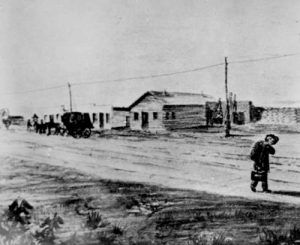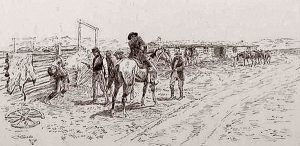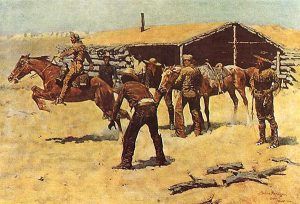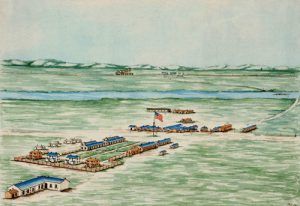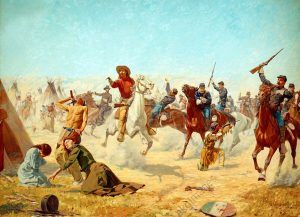Julesburg, Colorado – Wicked in the West – Legends of America (original) (raw)
The sleepy agricultural town of Julesburg, Colorado, wasn’t always quiet. In fact, it was once referred to as “The Wickedest City in the West.”
Located near the county’s northern border with Nebraska, Julesburg was once a busy way station along the 19th-century transportation routes.
When white settlers began to push westward, the area had long been called home to the Arapaho, Cheyenne, and other Plains tribes. In the 1840s, with the organization of the Oregon Territory and the California Gold Rush of 1849, Anglo-American traffic across the Colorado Plains increased dramatically.
In 1856, U.S. Army Lieutenant Francis Bryan found a Native American trail on the south side of the South Platte River with a crossing near present-day Julesburg. The army began using the route, and in the aftermath of the Colorado Gold Rush of 1859, it became part of the Overland Trail. Known by several names, including “Upper California Crossing” and “Morrell’s Crossing,” the area near here became a busy way station for westward-bound emigrants.
Around 1858, a half-French Canadian, half-Indian trapper named Jules Beni established a small trading post and saloon along the Upper Crossing. It was located on the south side of the Platte River between the present towns of Ovid and Julesburg.
Before building his trading post, Beni had been actively trading with the Indians. However, with the nearby California–Oregon Trail filled with emigrants headed west, he found it more profitable to trade with the travelers.
Julesburg Station, Colorado.
Soon, more people settled in the vicinity, and a cluster of half-dozen buildings were built, including a saloon and restaurant. The stop quickly became one of the best-known establishments between Missouri and Colorado and the largest settlement along the 350-mile stretch between Fort Kearny, Nebraska, and the new mining town of Denver, Colorado. As such, it became a rendezvous point for traders, Indian fighters, buffalo hunters, adventurers, and desperados and bandits. Seeing financial opportunities, Beni expanded his establishment to include a warehouse, blacksmith shop, and stable. The settlement became known as Julesburg after its proprietor.
In the summer of 1859, the struggling Jones & Russell Stagecoach Line chose Julesburg as the site where its two westbound lines would diverge – one to Denver, Colorado, and the other to Salt Lake City, Utah. When the stagecoach line came through, “Old Jules” Beni seemed the logical choice to manage the company’s station there. Later that year, Jones & Russell’s business failed and was reorganized as the Central Overland, California & Pike’s Peak Express Company. The stage company ran tri-weekly coaches to and from Denver carrying passengers, gold, and other express items.
Jack Slade killing Jules Beni, by Charles Russell.
The express company then hired Joseph “Jack” Slade, who had a reputation for being a fearless man on an extremely tough frontier, as superintendent of Central Overland’s Sweetwater Division, which included Julesburg. Slade discovered that Beni was not only a disinterested and corrupt station manager but also an outright outlaw. He soon fired him. Afterward, a feud between the two men began to brew and would persist for at least a year.
In March 1860, Beni filled Slade with bullets and buckshot, but, amazingly, Slade survived to return to his position. With revenge on his mind, Slade immediately began to search for the former station manager. In August 1861, Beni was found near Cold Springs Station, Wyoming, and Slade shot him several times and cut his ears off. He was said to have kept these as souvenirs, using one of the ears as a watch fob.
Pony Express Rider.
In the meantime, Julesburg had grown into a prominent stop along the Overland Trail and the Pony Express. By 1862, Julesburg featured a hotel, several houses, and a general store. On April 2, 1862, a post office was established.
Although the increased traffic on the trails was good for the settlement, it angered the Plains Indians, who had signed treaties with the Federal Government. These treaties guaranteed Native American sovereignty in exchange for safe passage for whites and allowing the government to build forts in their territory.
However, the treaties were being ignored. As a result, tensions between the Indians and white settlers erupted into the Colorado War, fought from 1863 to 1865 between the Cheyenne and Arapaho Nations and white settlers and soldiers. The number of conflicts peaked in the summer of 1864.
Fort Sedgewick, Colorado.
To protect the stage lines, emigrants, and the overland route to Denver, Camp Rankin (Fort Sedgwick) was established near Julesburg in 1864.
Tensions between Native Americans and whites in the area erupted into an all-out war after U.S. troops under Colonel John Chivington slaughtered more than 150 peaceful Cheyenne and Arapaho Indians in the Sand Creek Massacre on November 29, 1864. The area Indians soon banded together to seek revenge upon the whites.
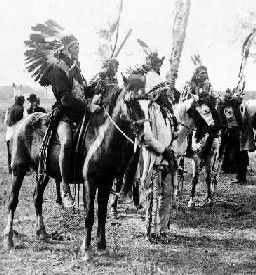
Sioux Warriors.
In the early morning hours of January 7, 1865, a retaliatory force of some 1,000 Sioux, Cheyenne, and Northern Arapaho Indians attacked Fort Rankin. In the resulting battle, 14 soldiers and four civilians were killed. Afterward, the Indians raced up the Platte River to the undefended settlement of Julesburg, where they looted the stage station, store, and warehouse, carrying away a large amount of plunder.
In a second attack, on February 2, 1865, the warriors burned Julesburg to the ground; however, they didn’t attack the soldiers and civilians holed up in the fort.
Before long, Julesburg residents staked out a new town three miles east just outside the Fort Sedgwick Military Reservation boundary. Some historians claim the move was made to allow the sale of whiskey. It was a busy stage station until the Union Pacific Railroad rails arrived north of the river.
A third Julesburg was founded when the end of the railroad track was moved several miles east. The community was known for its wicked and bawdy lifestyle during this time. Saloons, gambling houses, and prostitution parlors were thriving businesses as the population grew to nearly 3,000. It soon gained a reputation as “The Wickedest City in the West,” prompting both men and women on the streets to be fully armed.
J.P. Allen built the first hotel, and the Union Pacific Railroad arrived on June 23, 1867. By July 16, it boasted a telegraph office and a large freight house owned by the stage company Wells Fargo. However, as the railroad continued moving west, the town quickly faded and became known as Weir.
“No twenty-four hours passed without its contribution to Boot Hill, and homicide was performed in the most genial and whole-souled way.”
— General Grenville M. Dodge
Battle of Summit Springs, Colorado by Charles Schreyvogel, 1908.
In the meantime, the U.S. Army defeated Cheyenne leader Tall Bull’s Dog Soldiers at the Battle of Summit Springs in 1869, marking the end of Native American resistance on the Colorado plains. At that time, Fort Sedgwick declined in importance, and by 1870, just two barracks remained. The following year, the post was officially closed.
When the tracks stretched farther west, the fourth Julesburg was developed in 1886 at the junction of the Transcontinental Railroad and the Denver Branch of the Union Pacific Railroad. Located about four miles east of the third Julesburg, it was initially known as Denver Junction, but the town was soon renamed Julesburg, the last of Jules Beni’s namesakes. It became an important shipping hub for the area’s produce. The town was incorporated in 1886. By this time, Julesburg had settled down and had become an agricultural community.
In 1889, Sedgwick County was organized from a part of Logan County, and Julesburg was made the county seat.
In 1919, Julesburg’s first theater building was constructed specifically for the exhibition of motion pictures. The Hippodrome Theatre typifies the fantasy architecture of many small-town and neighborhood theaters constructed before 1930. It is located at 215 Cedar Street and is a movie theater today. It is listed on the National Register of Historic Places.
After the area’s sugar beet boom in the 1920s, the Union Pacific Railroad opened a new passenger and freight depot in Julesburg in 1930. Rail service moved passengers, crops, cattle, and locally manufactured items to points east and west of Julesburg. The Denver branch allowed local citizens to travel to and from the city and area merchants to get their goods to market. Today, the building, listed on the National Register of Historic Places, serves as a museum.
Like hundreds of other towns on the Great Plains, Julesburg suffered from the worsening Great Depression and the Dust Bowl in the 1930s.
Thanks, in part, to funding from the Works Progress Administration (WPA), one of President Franklin D. Roosevelt’s New Deal initiatives, Sedgwick County, gained a new courthouse in 1939. The building replaced a 1904 facility. Located at 315 Cedar Street, the structure is an excellent example of the WPA Art Deco style applied to many government buildings whose construction was constrained by the economic conditions of the Depression. Listed on the National Register of Historic Places, it continues to serve as the courthouse.
Today, Julesburg is home to about 1,241 people, and agriculture remains the backbone of its economy.
Julesburg’s rich history is on display at the Fort Sedgwick Museum at 114 E 1st Street, open year-round, and the Depot Museum at 201 W 1st Street, open during the summer season.
One of the best ways to see the area’s history is following Colorado’s shortest scenic byway – the South Platte River Trail. Beginning at the Colorado Welcome Center at 20934 County Road 28, this 19-mile loop features interpretive signage at the original Julesburg townsite, Colorado’s only Pony Express home station, and Fort Sedgwick. Additional markers commemorate the other three Julesburg townsites, the Transcontinental Railroad and the Lincoln Highway—the first coast-to-coast automobile road in the United States.
© Kathy Alexander/Legends of America, updated May 2024.
Also See:
Central Overland, California & Pike’s Peak Express Company
Joseph Slade – Hanged By Vigilantes
Jules Beni – Corruption and Violence in Old Julesburg
Sources:
Colorado Encyclopedia
Colorado Official State Web Portal
Julesburg, Colorado Historical Markers
South Platte River Trail
